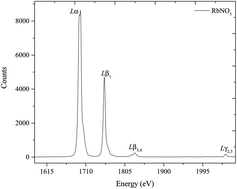High-resolution atomic structures of rubidium compounds in L X-ray spectral lines: a promising exploration for chemical analysis
Abstract
X-ray fluorescence (XRF) spectroscopy has made a significant impact on the chemical profile analysis of various materials used for industrial and medical purposes. In the early days of XRF spectral analysis, this technology was restricted to performing qualitative and quantitative analyses. The advantages of XRF technology have helped to improve the knowledge regarding the structure of compounds in a better way. The unique assets of high-resolution wavelength dispersive X-ray fluorescence (HR-WDXRF) make it possible to measure the atomic structure of various Rb compounds, which allows researchers to improve their knowledge of several atomic and fundamental parameters. The study of energy shifts with curved crystals provides a good opportunity to improve the performance of wavelength dispersive methods. In this work, unusual energy shifts have been measured for RbI, RbBr, RbCl and RbNO3 in the L spectral lines. For the first time, the atomic spectral structures associated with the satellite peaks and their energy differences have been reported. Two satellite peaks (Lα′ and Lα′′) in the Lα region and one satellite peak ( ) in the Lβ1 region were observed. To verify the source of these satellite lines, the theoretical energies were calculated by means of a general semi-empirical method developed within an intermediate-coupling framework; the values were found to be in close agreement with each other. The impacts of the chemical effect, ligand dependency, effective charge, crystal effect, intensity ratio and linewidth, shake process and shielding effect and their respective roles in various Rb compounds are also discussed in detail.
) in the Lβ1 region were observed. To verify the source of these satellite lines, the theoretical energies were calculated by means of a general semi-empirical method developed within an intermediate-coupling framework; the values were found to be in close agreement with each other. The impacts of the chemical effect, ligand dependency, effective charge, crystal effect, intensity ratio and linewidth, shake process and shielding effect and their respective roles in various Rb compounds are also discussed in detail.



 Please wait while we load your content...
Please wait while we load your content...